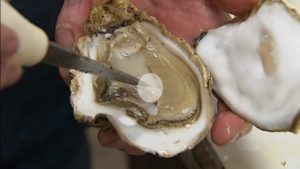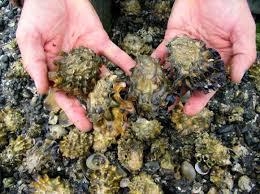As the state’s only shellfish hatchery, it’s a large part of the oyster industry in the region.
Alan Barton is the Production Manager at Whiskey Creek.
He’s worked there for the past decade and says they play a big part bringing shellfish from ocean to plate.
“We probably produce about a third of all oyster larvae on the West Coast,” says Barton.
In 2007 and 2008, the whole operation was nearly shut down.
Something changed in the waters of Netarts Bay, which Whiskey Creek uses to spawn oysters.
Their output was reduced by nearly 75 percent each year.
A hatchery out of business would have had a substantial impact on the oyster industry.
The Washington Shellfish Initiative estimated that shellfish growers employ, directly and indirectly, more than 3,200 people across the Pacific Northwest with an economic impact around $270 million.
“In these rural areas along the coastline, 3,000 jobs are pretty important,” says Barton. “These are just blue collar guys.”
Initially, Whiskey Creek Shellfish Hatchery staff believed their mass die-offs were caused by biological problems, like foreign bacteria – or the wrong type of algae used for food.
“I remember one morning, we came in and everything was dead, all of it,” says Barton.
“It was our worst day, but also our best day. Because it’s when we realized the problem might be with the water from the bay.”
That is when the hatchery turned to Oregon State University for help.
The Whiskey Creek Shellfish Hatchery believed “ocean acidification,” a byproduct of climate change, was to blame.
The National Oceanic and Atmospheric Association (NOAA) define ocean acidification, or “OA” for short as, “a reduction in the pH of the ocean over an extended period of time, caused primarily by uptake of carbon dioxide (CO2) from the atmosphere.”
In essence, more carbon dioxide in the atmosphere the more it will sink into the ocean.
Once enough of it gets into the water, it’s chemical makeup changes.
That can have a wide variety of effects on local animals and the ecosystem they live in.
George Waldbusser, Associate Professor at OSU, says ocean acidification is undoubtedly connected to climate change.
“By burning fossil fuels, we’ve increased the concentration of CO2 in the atmosphere by 30 percent,” he says. “That’s lowered the pH of the ocean — or the acidity of the ocean — by about 30 percent, which shifts the saturation state and makes it harder for organisms to make shells.”
The drop in acid in water is troubling for shellfish.
During the first two weeks of an oyster’s life they are especially sensitive to the level of oxygen and acid in the water.
In high acid events, oyster’s shells deform – and often times they die.
Waldbusser believes conditions will only get harder, not easier on shellfish.
“We know the chemistry will change and these extreme events will get worse and worse. And so periods of time that are easy or good to grow oysters will diminish in time for the hatchery,” he says.
Fortunately, OSU was able to help the Whiskey Creek Shellfish Hatchery.
Burke Hales, a professor at OSU, created a way to measure the chemistry of the water used to spawn shellfish.
That allows the hatchery to treat the water and provide a successful growing environment for their oysters.
“With that knowledge,” Hales says, “the Whiskey Creek folks are able to change their operations: the timing of their water pumping, how they condition the water. Now they’re back to almost 100 percent of their pre-crash productivity.”
But Hales believes the current method of overcoming ocean acidification is not a long-term solution.
“Netarts Bay has always had some good times; it’s always had some bad times. But the frequency of the good times is less and the frequency of the bad times is greater. And the bad times are a little bit worse than they used to be,” says Hales.
To combat the problem for the long term researchers at OSU point to reducing the amount of carbon dioxide released into the atmosphere which causes ocean acidification.
“We have to recognize that fossil fuel emissions are a cause of climate change and ocean acidification. We also have to recognize that we’ve relied on them for a long time and we have to find reasonable transition plans to move away from fossil fuels and into alternative energy,” says Waldbusser.
For Barton at the Whiskey Creeks Shellfish Hatchery, he’s thankful they’ve found a way to overcome the effect the effect carbon dioxide has had on the ocean.
“If we had not figured out what ocean acidification was doing to this hatchery we would for sure be out of business,” he says.
However, he is not confident their current techniques for treating the water will sustain them forever.
“The short term prospects are pretty good. But within the next couple of decades we’re going to cross a line I don’t think we’re going to be able to come back from,” he says. “A lot of people have the luxury of being skeptics about climate change and ocean acidification. But we don’t have that choice. If we don’t change the chemistry of the water going into our tanks, we’ll be out of business. It’s that simple for us.”
Originally published here

 TILLAMOOK, Ore. – The Whiskey Creek Shellfish Hatchery is quietly tucked away off the Netarts Bay in Tillamook.
TILLAMOOK, Ore. – The Whiskey Creek Shellfish Hatchery is quietly tucked away off the Netarts Bay in Tillamook. are absorbing increasing amounts of carbon dioxide from the atmosphere, so much so that the chemical balance of our oceans and coastal waters is changing and a growing threat to marine ecosystems. Over the past 200 years, the world’s seas have absorbed more than 150 billion metric tons of carbon from human activities. Currently, that’s a worldwide average of 15 pounds per person a week, enough to fill a coal train long enough to encircle the equator 13 times every year.
are absorbing increasing amounts of carbon dioxide from the atmosphere, so much so that the chemical balance of our oceans and coastal waters is changing and a growing threat to marine ecosystems. Over the past 200 years, the world’s seas have absorbed more than 150 billion metric tons of carbon from human activities. Currently, that’s a worldwide average of 15 pounds per person a week, enough to fill a coal train long enough to encircle the equator 13 times every year.

